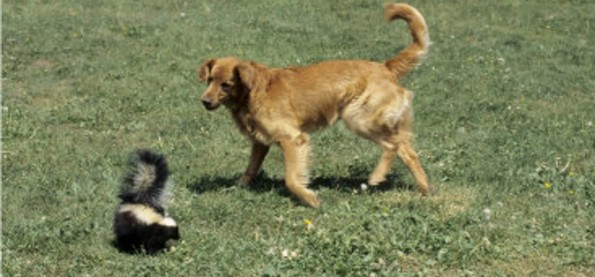
Dr. Shallen Langley’s “Skunked” Experience.
5:30am, alarm goes off…It is okay, the alarm is for my husband and I still have an hour before it is my turn to leave my warm bed.
5:45 am…”Pssst, Shallen”, I hear my husband’s whispered voice coming from the bottom of the stairs. “The dogs just got skunked”. You’re kidding!!!
I knew I had to get up to help my husband take care of our two 60 lb dogs, Oakley and Megs, though I was still very reluctant to get out of bed. My eyes popped open, and then started stinging from the fumes of ‘O-de-skunk” coming off of Oakley as soon as I got to the bottom of the stairs. Megs was still outside and I knew we had to get her in quickly or she would likely keep going after the skunk and I did not want to have to tend to bite wounds as well. Skunks can certainly be carriers of the rabies virus, but my dogs are luckily up to date on vaccines and so this was less of a concern.
Through stinging, tearing eyes (it really cannot be described how pungent the smell is until you have experienced it!) I mixed together the hydrogen peroxide, baking soda and dish detergent concoction to bathe the dogs with (see below). This would not be the last time we would have to bath them to try to dilute the persistent odor. Unfortunately skunk spray binds to the protein in the fur and skin and until both my dogs have completely shed and replaced all their current hairs they would carry the odor of skunk spray-especially noticeable when they get wet! While I made the shampoo my husband did his best to flush the dogs’ eyes with water from the shower head. The second unfortunate fact about skunk spray is that it is also lipophilic and repels water, so it is very difficult to flush out of the eyes. It is a strong irritant and can cause severe conjunctivitis and uveitis (inflammation of the outer eye and within the eye). The best thing I could do to prevent the discomfort and serious eye complications that could develop (especially in Megs who definitely got a whopping dose of skunk spray in the face) was to get a topical eye anti-inflammatory/antibiotic eye ointment and give an NSAID (metacam) for a few days. Specialists in zoonotic medicine suggest it is unlikely, but possible that Leptospirosis is shed in skunk spray of carrier skunks. Leptospirosis is a bacterium that is spread in the urine of carrier wildlife and our dogs that ingest grass or water that these animals have urinated on can develop kidney and liver failure within a few days of exposure. In addition, if my dogs became infected with leptospirosis and I or anyone in my family came in contact with their urine, we could become very ill. Due to the serious potential side effects of my dogs coming in contact with this bacteria and despite my dogs being vaccinated against leptospirosis, as a precaution I opted to start both dogs on a two week course of antibiotics. Some dogs can also develop a type of pneumonia and/or severe, life threatening anemia after being sprayed by a skunk, especially if they get a large dose of it in the face. Luckily my dogs did not develop any symptoms of difficulty breathing or pale gums.
That night had a dream that I could smell skunk while I was sleeping. Was it just in my nose? My answer came the next day I went to work. Even though my coat had been in a closet at home and not in the same space as the dogs, within minutes of me getting to work my coat was exiled, separated from everyone else’s coats and put into a different room behind closed doors. Clients I saw that day were nice enough to say I did not smell like skunk, but my coworkers assured me that was not the case. My husband now always turns the porch light on a few minutes prior to taking the dogs out on a leash in the mornings and any time after dusk.
Skunk Recipe
1 quart 3% hydrogen peroxide
¼ cup baking soda
1 tsp. liquid dish soap
